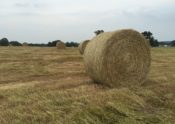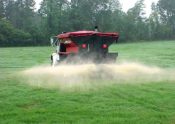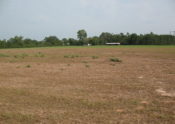
Merry Christmas from my family to yours! Wishing everyone a joyous holiday season. Vanessa Corriher-Olson, Ph.D. Professor, Forage Extension Specialist Soil & Crop Sciences Texas A&M AgriLife Extension, Overton,TX vacorriher@ag.tamu.edu 903-834-6191

There are often many questions surrounding the practice of burning pastures and hayfields. Let’s look at the more frequently asked questions. Is it a good idea to burn my hayfield? There are several benefits to burning your hayfield. Burning can help producers manage thatch in their stands. If the thatch layer becomes too thick over time, several issues can occur. For example, thatch can tie up nutrients and serve as a “spore reservoir” for leaf spot diseases. Thick thatch layers can also hinder or delay green up,… Read More →

Potassium is an essential element in plants and is considered one of the three macronutrients, along with nitrogen and phosphorus. The amount of K is reported in almost all routine soil samples. Unfortunately, at times potassium can go from being the least expensive to the most expensive of the three macronutrients. Ignoring the importance of potassium fertilization and not maintaining adequate soil levels can lead to forage losses and ultimate stand decline. Potassium is essential for producing economical yields and maintaining persistence in our forages. The role of… Read More →

Buttercup (Ranunculus spp) Spray buttercup in late February or early March before it flowers. This weed is easily controlled with 2,4-D amine, Metsulfuron 60 DF, Cimarron Plus, Grazon P+D, GrazonNext HL and dicamba + 2,4-D (Weedmaster). In dormant bermudagrass/bahiagrass glyphosate (Roundup) will control buttercup at normal use rates. Groundsel (Senecio spp) Metsulfuron 60DF or Cimarron Plus has proved to be the most effective herbicide for groundsel control. Apply in the rosette stage (~March). Grazon P+D provides partial control. Red Sorrel (Rumex acetosella) Grazon P+D provides… Read More →

Preparing for the Next Drought If your crystal ball is not working it is always better to be safe than sorry when it comes to a potential drought because another drought will occur, the prediction is when. Some best management practices can prepare us for a potential drought: forage management, grazing management and utilization of warm-season annual forages. Forage management: It is always important, drought or not, to pay attention to plant nutrient requirements. Soil test, apply the needed fertilizer and hope for rain. Ensure soil pH is… Read More →

Dealing with Drought During a drought, little can be done to increase forage pasture growth. Proper management can minimize impacts of drought on your operation when it does, and it will, occur. Careful management early in a drought can minimize long term stand damage and help maintain forage yields when rains do come. If pastures are managed properly during times of low moisture, the effects of drought will be less severe and pastures will rebound faster when precipitation is sufficient. Remember, management practices that minimize damage to pastures… Read More →

As forage producers, we focus most of our energy on our warm season perennial pastures and hay meadows (bermudagrass, bahiagrass, etc.). That means most of our weed control efforts are also focused on warm season weeds (such as carolina horsenettle, blackberry, etc). Unfortunately, cool season weeds can be just as detrimental to our warm season perennial forages. Annual ryegrass…a cool season annual forage often utilized by livestock producers for winter grazing. However, it’s often deemed an enemy of many a hay producer in East Texas. Later maturity… Read More →

If left uncontrolled, thick thistle stands can reduce grazing and result in less forage production. A single thistle plant can produce at least 4,000 seeds, which increases the chance for higher thistle populations in the pasture the following year. Consequently, management practices need to be conducted prior to flower formation for effective thistle control. Even if thistles have not infested your pasture in the past, it is ideal that your pastures are scouted in late fall through mid-spring (November to March) to ensure that thistles do not get… Read More →

On many farms, hay feeding losses are as high as storage losses. Some hay losses during feeding can be expected with any feeding system, but the amount of loss varies with the system used. The major objective for any feeding system should be to keep loses to a practical minimum level, thus permitting animals to consume the majority of hay offered at feeding. Feeding losses include trampling, leaf shatter, chemical and physical deterioration, fecal contamination, and refusal. Feeding in only one area can cause excessive sod destruction, usually… Read More →

Fertilization of winter pasture should be based on a soil test to maximize forage production and prevent applying more fertilizer than is needed. Nitrogen fertilization of small grain and small grain-ryegrass mixtures can be split in 2 to 4 equal applications during the growing season. Two applications are often sufficient in Central Texas with lower rainfall and heavier textured soils. Three or four applications are required on the sandy soils in East Texas because of low nutrient holding capacity and high rainfall. Phosphorus and potassium can be applied… Read More →